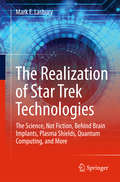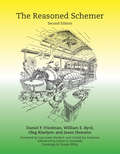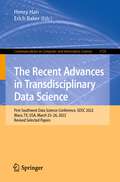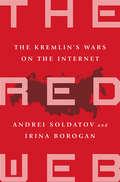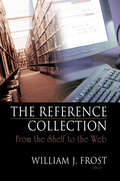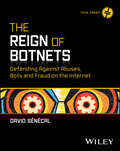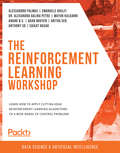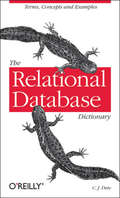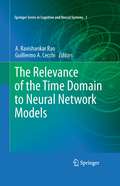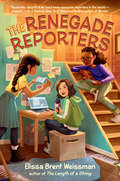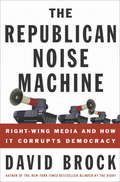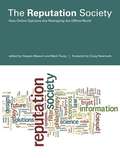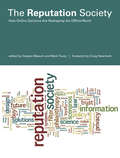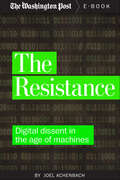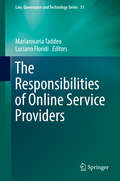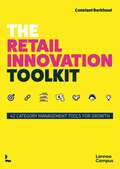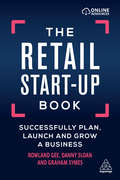- Table View
- List View
The Reality of the Artificial
by Massimo NegrottiThe human ambition to reproduce and improve natural objects and processes has a long history, and ranges from dreams to actual design, from Icarus's wings to modern robotics and bioengineering. This imperative seems to be linked not only to practical utility but also to our deepest psychology. Nevertheless, reproducing something natural is not an easy enterprise, and the actual replication of a natural object or process by means of some technology is impossible. In this book the author uses the term naturoid to designate any real artifact arising from our attempts to reproduce natural instances. He concentrates on activities that involve the reproduction of something existing in nature, and whose reproduction, through construction strategies which differ from natural ones, we consider to be useful, appealing or interesting. The development of naturoids may be viewed as a distinct class of technological activity, and the concept should be useful for methodological research into establishing the common rules, potentialities and constraints that characterize the human effort to reproduce natural objects. The author shows that a naturoid is always the result of a reduction of the complexity of natural objects, due to an unavoidable multiple selection strategy. Nevertheless, the reproduction process implies that naturoids take on their own new complexity, resulting in a transfiguration of the natural exemplars and their performances, and leading to a true innovation explosion. While the core performances of contemporary naturoids improve, paradoxically the more a naturoid develops the further it moves away from its natural counterpart. Therefore, naturoids will more and more affect our relationships with advanced technologies and with nature, but in ways quite beyond our predictive capabilities. The book will be of interest to design scholars and researchers of technology, cultural studies, anthropology and the sociology of science and technology.
The Realization of Star Trek Technologies
by Mark E. LasburyAs Star Trek celebrates its 50th anniversary, the futuristic tools of Kirk, Spock, Scott, and McCoy continue to come to life. This book merges Star Trek scientific lore - how the science of the time informed the implementation of technology in the series - and the science as it is playing out today. Scientists and engineers have made and continue to develop replicators, teletransporters, tractor beams, and vision restoring visors. This book combines the vision of 1966 science fiction with the latest research in engineering, physics, and biotechnology.
The Reasoned Schemer, second edition (The\mit Press Ser.)
by Daniel P. Friedman Oleg Kiselyov William E. Byrd Jason HemannA new edition of a book, written in a humorous question-and-answer style, that shows how to implement and use an elegant little programming language for logic programming.The goal of this book is to show the beauty and elegance of relational programming, which captures the essence of logic programming. The book shows how to implement a relational programming language in Scheme, or in any other functional language, and demonstrates the remarkable flexibility of the resulting relational programs. As in the first edition, the pedagogical method is a series of questions and answers, which proceed with the characteristic humor that marked The Little Schemer and The Seasoned Schemer. Familiarity with a functional language or with the first five chapters of The Little Schemer is assumed. For this second edition, the authors have greatly simplified the programming language used in the book, as well as the implementation of the language. In addition to revising the text extensively, and simplifying and revising the “Laws” and “Commandments,” they have added explicit “Translation” rules to ease translation of Scheme functions into relations.
The Recent Advances in Transdisciplinary Data Science: First Southwest Data Science Conference, SDSC 2022, Waco, TX, USA, March 25–26, 2022, Revised Selected Papers (Communications in Computer and Information Science #1725)
by Henry Han Erich BakerThis book constitutes the refereed proceedings of the First Southwest Data Science Conference, on The Recent Advances in Transdisciplinary Data Science, SDSC 2022, held in Waco, TX, USA, during March 25–26, 2022.The 14 full papers and 2 short papers included in this book were carefully reviewed and selected from 72 submissions. They were organized in topical sections as follows: Business and social data science; Health and biological data science; Applied data science, artificial intelligence, and data engineering.
The Recursive Book of Recursion: Ace the Coding Interview with Python and JavaScript
by Al SweigartAn accessible yet rigorous crash course on recursive programming using Python and JavaScript examples.Recursion has an intimidating reputation: it&’s considered to be an advanced computer science topic frequently brought up in coding interviews. But there&’s nothing magical about recursion. The Recursive Book of Recursion uses Python and JavaScript examples to teach the basics of recursion, exposing the ways that it&’s often poorly taught and clarifying the fundamental principles of all recursive algorithms. You&’ll learn when to use recursive functions (and, most importantly, when not to use them), how to implement the classic recursive algorithms often brought up in job interviews, and how recursive techniques can help solve countless problems involving tree traversal, combinatorics, and other tricky topics. This project-based guide contains complete, runnable programs to help you learn: How recursive functions make use of the call stack, a critical data structure almost never discussed in lessons on recursionHow the head-tail and &“leap of faith&” techniques can simplify writing recursive functionsHow to use recursion to write custom search scripts for your filesystem, draw fractal art, create mazes, and moreHow optimization and memoization make recursive algorithms more efficient Al Sweigart has built a career explaining programming concepts in a fun, approachable manner. If you&’ve shied away from learning recursion but want to add this technique to your programming toolkit, or if you&’re racing to prepare for your next job interview, this book is for you.
The Red Web: The Struggle Between Russia's Digital Dictators and the New Online Revolutionaries
by Andrei Soldatov Irina BoroganHalf of Russia’s email traffic passes through an ordinary-looking building in an otherwise residential district of South West Moscow. On the eighth floor, in here a room occupied by the FSB, the successor organization to the KGB, is a box the size of a VHS player, marked SORM. SORM once intercepted just phone calls. Now it monitors emails, internet usage, Skype, and all social networks. It is the world’s most intrusive listening device, and it is the Russian Government’s front line for the battle of the future of the internet. Drawn from scores of interviews personally conducted with numerous prominent officials in in the ministry of communications and web-savvy activists challenging the state, Andrei Soldatov and Irina Borogan’s fearless investigative reporting in The Red Web is both harrowing and alarming. They explain the long and storied history of Russian advanced surveillance systems, from research laboratories in Soviet era labor camps to the legalization of government monitoring of all telephone and internet communications in 1995. But for every hacker subcontracted by the FSB to interfere with Russia’s antagonists abroad—such as those who in a massive Denial of Service attack overwhelmed the entire internet in neighboring Estonia—there is a radical or an opportunist who is using the web to chip away at the power of the state at home. Empowered by communication enabled by social media, a community of activists, editors, programmers and others are finding ways to challenge abusive state powers online. Alexei Navalny used his LiveJournal to expose political corruption in Russian, and gained a viral following after attacking Putin’s “party of crooks and thieves. ” Grigory Melkonyants, deputy director of the nation’s only independent election watchdog organization, developed a visual that tracked and mapped voter fraud across the country. And on December 10th, 2011 50,000 people crowded Bolotnaya Square to protest United Russia and its lawless practices. Twenty-four-year-old Ilya Klishin had used Facebook to spark the largest organized demonstration in Moscow since the dying days of the Soviet Union. The internet in Russia is either the most efficient totalitarian tool or the very device by which totalitarianism will be overthrown. Perhaps both. The Red Web exposes how easily a free global exchange can be splintered coerced into becoming a tool of geopolitical warfare. Without much-needed activism or regulation, the Internet will no longer be a safe and egalitarian public forum—but instead a site Balkanized and policed to suit the interests and agendas of the world’s most hostile governments.
The Reference Collection: From the Shelf to the Web
by Linda S KatzStay up-to-date with the growing amount of reference resources available onlineHow important is the World Wide Web to information retrieval and communication? Important enough that information professionals have seen students exit from their libraries en masse when Internet service was lost. Internet providers dominate the indexing and abstracting of periodical articles as major publishers now offer nearly all of their reference titles in digital form. Libraries spend increasing amounts of funding on electronic reference materials, and librarians devote an increasing amount of time to assisting in their use. The Reference Collection: From the Shelf to the Web is an essential guide to collection development for electronic materials in academic and public libraries. The Reference Collection: From the Shelf to the Web tracks the continuing evolution of electronic reference resources-and how they&’re accessed-in a variety of settings. Librarians representing university, elementary school, and public libraries in the United States and Australia examine how reference collections have evolved over time (and may soon be a thing of the past); how public and school libraries have dealt with the changes; why library research assignments have become more difficult for teachers to make and for students to complete; how to organize online reference sources; and why the nature of plagiarism has changed in the electronic era. The book also examines the use of electronic references from a publisher&’s perspective and looks at the most important Web-accessible reference tools-both free and subscription-in the areas of humanities, medicine, the social sciences, business, and education. The Reference Collection: From the Shelf to the Web also examines: issues of authority, accessibility, cost, comfort, and user education in evaluating electronic resources the formation of purchasing consortia to facilitate the transfer of reference materials from print to online formats current literature and research findings on the state of digital versus print reference collections what electronic publishing means to smaller reference books (dictionaries, almanacs, etc.) the need for increased information literacy among students the nature, extent, and causes of cyber plagiarism the use of federated search tools and includes a selected list of the top 100 free Internet reference sitesThe Reference Collection: From the Shelf to the Web is an essential resource for all reference and collection development librarians, and an invaluable aid for publishing professionals.
The Regularization Cookbook: Explore practical recipes to improve the functionality of your ML models
by Vincent VandenbusscheMethodologies and recipes to regularize any machine learning and deep learning model using cutting-edge technologies such as stable diffusion, Dall-E and GPT-3 Purchase of the print or Kindle book includes a free PDF eBookKey FeaturesLearn to diagnose the need for regularization in any machine learning modelRegularize different ML models using a variety of techniques and methodsEnhance the functionality of your models using state of the art computer vision and NLP techniquesBook DescriptionRegularization is an infallible way to produce accurate results with unseen data, however, applying regularization is challenging as it is available in multiple forms and applying the appropriate technique to every model is a must. The Regularization Cookbook provides you with the appropriate tools and methods to handle any case, with ready-to-use working codes as well as theoretical explanations. After an introduction to regularization and methods to diagnose when to use it, you’ll start implementing regularization techniques on linear models, such as linear and logistic regression, and tree-based models, such as random forest and gradient boosting. You’ll then be introduced to specific regularization methods based on data, high cardinality features, and imbalanced datasets. In the last five chapters, you’ll discover regularization for deep learning models. After reviewing general methods that apply to any type of neural network, you’ll dive into more NLP-specific methods for RNNs and transformers, as well as using BERT or GPT-3. By the end, you’ll explore regularization for computer vision, covering CNN specifics, along with the use of generative models such as stable diffusion and Dall-E. By the end of this book, you’ll be armed with different regularization techniques to apply to your ML and DL models.What you will learnDiagnose overfitting and the need for regularizationRegularize common linear models such as logistic regression Understand regularizing tree-based models such as XGBoosUncover the secrets of structured data to regularize ML modelsExplore general techniques to regularize deep learning modelsDiscover specific regularization techniques for NLP problems using transformers Understand the regularization in computer vision models and CNN architecturesApply cutting-edge computer vision regularization with generative modelsWho this book is forThis book is for data scientists, machine learning engineers, and machine learning enthusiasts, looking to get hands-on knowledge to improve the performances of their models. Basic knowledge of Python is a prerequisite.
The Regularized Fast Hartley Transform
by Keith JonesThe Regularized Fast Hartley Transform provides the reader with the tools necessary to both understand the proposed new formulation and to implement simple design variations that offer clear implementational advantages, both practical and theoretical, over more conventional complex-data solutions to the problem. The highly-parallel formulation described is shown to lead to scalable and device-independent solutions to the latency-constrained version of the problem which are able to optimize the use of the available silicon resources, and thus to maximize the achievable computational density, thereby making the solution a genuine advance in the design and implementation of high-performance parallel FFT algorithms.
The Regularized Fast Hartley Transform: Low-Complexity Parallel Computation of the FHT in One and Multiple Dimensions
by Keith John JonesThis book describes how a key signal/image processing algorithm – that of the fast Hartley transform (FHT) or, via a simple conversion routine between their outputs, of the real‑data version of the ubiquitous fast Fourier transform (FFT) – might best be formulated to facilitate computationally-efficient solutions. The author discusses this for both 1-D (such as required, for example, for the spectrum analysis of audio signals) and m‑D (such as required, for example, for the compression of noisy 2-D images or the watermarking of 3-D video signals) cases, but requiring few computing resources (i.e. low arithmetic/memory/power requirements, etc.). This is particularly relevant for those application areas, such as mobile communications, where the available silicon resources (as well as the battery-life) are expected to be limited. The aim of this monograph, where silicon‑based computing technology and a resource‑constrained environment is assumed and the data is real-valued in nature, has thus been to seek solutions that best match the actual problem needing to be solved.
The Regulated Internet: Europe's Quest for Digital Sovereignty (Professional Practice in Governance and Public Organizations)
by Vittorio Bertola Stefano QuintarelliThe Internet was once envisioned as a borderless realm, promising to unify nations into a peaceful global society and empower individuals with unlimited access to knowledge. Supported by Western deregulation, this dream flourished - until recently. The European Union's introduction of strict laws governing privacy, competition, and content moderation marked a turning point that shocked big tech and initiated a wave of regulations worldwide. In this book, two leading European experts present the reasons behind this seismic shift. They explain how American dominance by a few colossal companies has reshaped our online lives and triggered a movement towards a regulated Internet. This insightful book also offers perspectives on future developments, emphasizing that our collective decisions shape the digital landscape. This book is a must-read for anyone seeking to understand the changing landscape of Internet governance and its global implications.
The Reign of Botnets: Defending Against Abuses, Bots and Fraud on the Internet (Tech Today)
by David SenecalA top-to-bottom discussion of website bot attacks and how to defend against them In The Reign of Botnets: Defending Against Abuses, Bots and Fraud on the Internet, fraud and bot detection expert David Senecal delivers a timely and incisive presentation of the contemporary bot threat landscape and the latest defense strategies used by leading companies to protect themselves. The author uses plain language to lift the veil on bots and fraud, making a topic critical to your website's security easy to understand and even easier to implement. You'll learn how attackers think, what motivates them, how their strategies have evolved over time, and how website owners have changed their own behaviors to keep up with their adversaries. You'll also discover how you can best respond to patterns and incidents that pose a threat to your site, your business, and your customers. The book includes: A description of common bot detection techniques exploring the difference between positive and negative security strategies and other key concepts A method for assessing and analyzing bot activity, to evaluate the accuracy of the detection and understand the botnet sophistication A discussion about the challenge of data collection for the purpose of providing security and balancing the ever-present needs for user privacy Ideal for web security practitioners and website administrators, The Reign of Botnets is the perfect resource for anyone interested in learning more about web security. It's a can't-miss book for experienced professionals and total novices alike.
The Reinforcement Learning Workshop: Saikat Basak is a data scientist and a passionate programmer. Having worked with multiple industry leaders, he has a good understanding of problem areas that can potentially be solved using data. Apart from being a data guy, he is also a science geek and loves to explore new ideas in the...
by Alessandro Palmas Emanuele GhelfiIf you are a data scientist, machine learning enthusiast, or a Python developer who wants to learn basic to advanced deep reinforcement learning algorithms, this workshop is for you. A basic understanding of the Python language is necessary.
The Relational Database Dictionary: A Comprehensive Glossary of Relational Terms and Concepts, with Illustrative Examples
by C. J. DateAvoid misunderstandings that can affect the design, programming, and use of database systems. Whether you're using Oracle, DB2, SQL Server, MySQL, or PostgreSQL, The Relational Database Dictionary will prevent confusion about the precise meaning of database-related terms (e.g., attribute, 3NF, one-to-many correspondence, predicate, repeating group, join dependency), helping to ensure the success of your database projects. Carefully reviewed for clarity, accuracy, and completeness, this authoritative and comprehensive quick-reference contains more than 600 terms, many with examples, covering issues and concepts arising from the relational model of data. This one-of-a-kind dictionary provides a single, compact source where DBAs, database designers, DBMS implementers, application developers, and database professors and students can find the accurate definitions they need on a daily basis, information that isn't readily available anywhere else. If you're working with or learning about relational databases, you need this pocket-sized quick-reference.
The Relevance of the Time Domain to Neural Network Models
by Guillermo A. Cecchi A. Ravishankar RaoA significant amount of effort in neural modeling is directed towards understanding the representation of information in various parts of the brain, such as cortical maps [6], and the paths along which sensory information is processed. Though the time domain is integral an integral aspect of the functioning of biological systems, it has proven very challenging to incorporate the time domain effectively in neural network models. A promising path that is being explored is to study the importance of synchronization in biological systems. Synchronization plays a critical role in the interactions between neurons in the brain, giving rise to perceptual phenomena, and explaining multiple effects such as visual contour integration, and the separation of superposed inputs. The purpose of this book is to provide a unified view of how the time domain can be effectively employed in neural network models. A first direction to consider is to deploy oscillators that model temporal firing patterns of a neuron or a group of neurons. There is a growing body of research on the use of oscillatory neural networks, and their ability to synchronize under the right conditions. Such networks of synchronizing elements have been shown to be effective in image processing and segmentation tasks, and also in solving the binding problem, which is of great significance in the field of neuroscience. The oscillatory neural models can be employed at multiple scales of abstraction, ranging from individual neurons, to groups of neurons using Wilson-Cowan modeling techniques and eventually to the behavior of entire brain regions as revealed in oscillations observed in EEG recordings. A second interesting direction to consider is to understand the effect of different neural network topologies on their ability to create the desired synchronization. A third direction of interest is the extraction of temporal signaling patterns from brain imaging data such as EEG and fMRI. Hence this Special Session is of emerging interest in the brain sciences, as imaging techniques are able to resolve sufficient temporal detail to provide an insight into how the time domain is deployed in cognitive function. The following broad topics will be covered in the book: Synchronization, phase-locking behavior, image processing, image segmentation, temporal pattern analysis, EEG analysis, fMRI analyis, network topology and synchronizability, cortical interactions involving synchronization, and oscillatory neural networks. This book will benefit readers interested in the topics of computational neuroscience, applying neural network models to understand brain function, extracting temporal information from brain imaging data, and emerging techniques for image segmentation using oscillatory networks
The Renegade Reporters
by Elissa Brent WeissmanWhen Ash gets kicked off her school's news show, she becomes a renegade reporter--and makes a big discovery about technology and her fellow students' privacy.Ash and her friends are reporters. They were ready to lead their school news show, The News at Nine, sponsored by Van Ness Media, when an unfortunate incident involving a dancing teacher, an irresponsibly reported story, and a viral video got them kicked off the crew. So Ash, Maya, and Brielle decide to start their own news show, The Underground News. And soon they stumble on a big lead: Van Ness Media, the educational company that provides their school's software, has been gathering data from all the kids at school. Their drawings, their journals, even their movements are being recorded and cataloged by Van Ness Media. But why? Ash and her friends are determined to learn the truth and report it.
The Republican Noise Machine: Right-Wing Media and How It Corrupts Democracy
by David BrockIn The Republican Noise Machine, David Brock skillfully documents perhaps the most important but least understood political development of the last thirty years: how the Republican Right has won political power and hijacked public discourse in the United States.Brock, a former right-wing insider and the author of the New York Times bestseller Blinded by the Right, uses his keen understanding of the strategies, tactics, financing, and personalities of the American right wing to demonstrate how the once-fringe phenomenon of right-wing media has all but subsumed the regular media conversation, shaped the national consciousness, and turned American politics sharply to the right.Brock documents how in the last several decades the GOP built a powerful media machine--newspapers and magazines, think tanks, talk radio networks, op-ed columnists, the FOX News Channel, Christian Right broadcasting, book publishers, and high-traffic internet sites--to sell conservatism to the public and discredit its opponents. This unabashedly biased multibillion-dollar communications empire disregards journalistic ethics and universal standards of fairness and accuracy, manufacturing "news" that is often bought and paid for by a tight network of corporate-backed foundations and old family fortunes. By dissecting the appeal, techniques, and reach of the booming right-wing media market, Brock demonstrates that it is largely based on bigotry, ignorance, and emotional manipulation closely tied to America’s longstanding cultural divisions and the buying power of anti-intellectual traditionalists. From the disputed 2000 presidential election to the war with Iraq to the political battles of 2004, Brock's penetrating analysis of right-wing media theories and methodology reveals that the Republican Right views the media as an extension of a broader struggle for political power. By tracing the political impact of right-wing media, Brock shows how disproportionate conservative influence in the media is integrally linked to the Republican Right’s current domination of all three branches of government, to the propping up of the Bush administration, and to the inability of Democrats to voice their opposition to this political sea change or to compete on an even playing field.As only an ex-conservative intimately familiar with the imperatives of the American right wing could, David Brock suggests ways in which concerned Americans can begin to redress the conservative ascendancy and cut through the propagandistic fog. Writing with verve and deep insight, he reaches far beyond typical bromides about media bias to produce an invaluable account of the rise of right-wing media and its political consequences. Promising to be the political book of the year, The Republican Noise Machine will transform the raging yet heretofore unsatisfying debate over the politics of the media for years to come.
The Reputation Society: How Online Opinions Are Reshaping the Offline World
by Mark Tovey Hassan MasumIn making decisions, we often seek advice. Online, we check Amazon recommendations, eBay vendors' histories, TripAdvisor ratings, and even our elected representatives' voting records. These online reputation systems serve as filters for information overload. In this book, experts discuss the benefits and risks of such online tools. The contributors offer expert perspectives that range from philanthropy and open access to science and law, addressing reputation and reputation systems in theory and practice. Properly designed reputation systems, they argue, have the potential to create a "reputation society," reshaping society for the better by promoting accountability through the mediated judgments of billions of people. Effective design can also steer systems away from the pitfalls of online opinion sharing by motivating truth-telling, protecting personal privacy, and discouraging digital vigilantism.
The Reputation Society: How Online Opinions Are Reshaping the Offline World (The Information Society Series)
by Mark Tovey edited by Hassan MasumExperts discuss the benefits and risks of online reputation systems.In making decisions, we often seek advice. Online, we check Amazon recommendations, eBay vendors' histories, TripAdvisor ratings, and even our elected representatives' voting records. These online reputation systems serve as filters for information overload. In this book, experts discuss the benefits and risks of such online tools.The contributors offer expert perspectives that range from philanthropy and open access to science and law, addressing reputation systems in theory and practice. Properly designed reputation systems, they argue, have the potential to create a “reputation society,” reshaping society for the better by promoting accountability through the mediated judgments of billions of people. Effective design can also steer systems away from the pitfalls of online opinion sharing by motivating truth-telling, protecting personal privacy, and discouraging digital vigilantism.Contributors Madeline Ashby, Jamais Cascio, John Henry Clippinger, Chrysanthos Dellarocas, Cory Doctorow, Randy Farmer, Eric Goldman, Victor Henning, Anthony Hoffmann, Jason Hoyt, Luca Iandoli, Josh Introne, Mark Klein, Mari Kuraishi, Cliff Lampe, Paolo Massa, Hassan Masum, Marc Maxson, Craig Newmark, Michael Nielsen, Lucio Picci, Jan Reichelt, Alex Steffen, Lior Strahilevitz, Mark Tovey, John Whitfield, John Willinsky, Yi-Cheng Zhang, Michael Zimmer
The Resistance: Digital dissent in the age of machines
by Joel Achenbach The Washington PostWashington Post reporter Joel Achenbach explores our relationship with technology—frequently beneficial, occasionally adversarial, and rapidly changing in a world growing more connected by the minute. In the second decade of this new millennium, we are more connected than we have ever been, and digital utopians speak of the new wonders ahead—artificial intelligence and augmented intelligence, a merger of humans and machines, and a coming era of transhumanism that we cannot possibly imagine. But there are dissenters. They see the rise of a surveillance state. They see personal data turned into a commodity. They see profits swirling to a few huge corporations. They see basic human interactions impaired by gadgetry. The most apocalyptic thinkers fear that machines will soon escape our control. They believe artificial intelligence will be our most catastrophic invention. These people do not form a coherent movement. But if they share a common message, it's that technology should serve humans and not the other way around. Joel Achenbach explores his own relationship with the digital revolution, as well as its future, in this eye-opening, intelligent, and entertaining look at how we connect today.
The Respiratory System in Equations
by Bertrand MauryThis book proposes an introduction to the mathematical modeling of the respiratory system. A detailed introduction on the physiological aspects makes it accessible to a large audience without any prior knowledge on the lung. Different levels of description are proposed, from the lumped models with a small number of parameters (Ordinary Differential Equations), up to infinite dimensional models based on Partial Differential Equations. Besides these two types of differential equations, two chapters are dedicated to resistive networks, and to the way they can be used to investigate the dependence of the resistance of the lung upon geometrical characteristics. The theoretical analysis of the various models is provided, together with state-of-the-art techniques to compute approximate solutions, allowing comparisons with experimental measurements. The book contains several exercises, most of which are accessible to advanced undergraduate students.
The Responsibilities of Online Service Providers
by Luciano Floridi Mariarosaria TaddeoThis volume focuses on the responsibilities of online service providers (OSPs) in contemporary societies. It examines the complexity and global dimensions of the rapidly evolving and serious challenges posed by the exponential development of Internet services and resources. It looks at the major actors - such as Facebook, Google, Twitter, and Yahoo! - and their significant influence on the informational environment and users' interactions within it, as well as the responsibilities and liabilities such influence entails. It discusses the position of OSPs as information gatekeepers and how they have gone from offering connecting and information-sharing services to paying members to providing open, free infrastructure and applications that facilitate digital expression and the communication of information. The book seeks consensus on the principles that should shape OSPs' responsibilities and practices, taking into account business ethics and policies. Finally, it discusses the rights of users and international regulations that are in place or currently lacking.
The Responsive Web: The Web - Past, Present, Future
by Matthew CarverSummaryThe Responsive Web is an easy-to-read introduction to responsive web design packed with instantly useful tips and techniques, and dozens of examples that show you exactly how to benefit from this valuable approach. You'll learn innovative ways to use what you already know along with design techniques leveraging new HTML5 and CSS3 features.Purchase of the print book includes a free eBook in PDF, Kindle, and ePub formats from Manning Publications.About the BookIn a world of mobile devices, new browsers, and changing standards, each page of your website can require an unmanageably large number of separate designs. Responsive web design is a set of techniques that allow you to design pages that efficiently adapt to whatever device or platform loads them. For web designers and developers and their customers, responsive design can be a big win.The Responsive Web builds on the best practices that have shaken out over a few years of production experience. This concise book skips pure theory and shows you exactly how to make responsive web design work for you in the real world. You'll learn innovative ways to use what you already know along with design techniques leveraging new HTML5 and CSS3 features. Along the way, you'll discover strategies to balance apps and websites, manage browser incompatibilities, and learn when multiple versions are the best option.What's InsideResponsive design conceptsCSS preprocessingRapid prototyping techniquesFluid typographyFuture-proof designs About the AuthorMatthew Carver is a front-end developer and web designer with real-world responsive design experience for clients like American Airlines, The Dallas Morning News, and Chobani Yogurt.Table of ContentsPART 1 THE RESPONSIVE WAYLearning to work responsivelyDesign for mobile firstPART 2 DESIGNING FOR THE RESPONSIVE WEBUsing style tiles to communicate designResponsive user experience design patternsResponsive layoutsAdding content modules and typographyPART 3 EXPANDING THE DESIGN WITH CODEAdding graphics in the browser with CSSProgressive enhancement and obsolescence control with ModernizrTesting and optimization for responsive websites
The Retail Innovation Toolkit: 42 Category Management Tools for Growth
by Constant BerkhoutHOW TO: design an enjoyable and/or efficient shopper experience. adapt your retail format to new societal trends while keeping the retail brand differentiating. energize supplier-retailer relationships and face the challenges ahead in an open and a collaborative way. Retail is going through tremendous change as a result of new types of competitors and ever higher consumer expectations. An abundance of products, media and data has become available. Digitization and the demand for an inclusive and a sustainable society call for new ways of defining the future together. Everyone needs to be mobilized, and the category level holds the right meeting point for suppliers and retailers. The Retail Innovation Toolkit offers practical tools and case studies on the way forward, so that professionals on both retail and supplier sides can start addressing category challenges immediately. The 42 tools help professionals to analyse, grow, innovate and even reinvent categories in a fun and a quick manner. The Category Management concept is refreshed by integrating tools from Experience Design and Product Innovation to create a new set of innovation skills and mobilize collaboration within and among retailer and supplier organizations. This is an excellent toolkit with practical approaches to growing the category and reinventing the retail game.
The Retail Start-Up Book: Successfully Plan, Launch and Grow a Business
by Rowland Gee Danny Sloan Graham SymesThe retail market in the UK is worth more than £400 billion annually and employs over 3 million workers, while in the US 29 million people create over USD $4 trillion of revenue through the industry. Despite the challenge to establish stores and big-box retailers, there's a rapid increase in the number of retail start-ups and consistent growth in the independent sector. From beard shops and barbers, through cafes and coffee shops, to 'retailment' concept stores and boutique consumer-focused experiences, the specialist retail sector is booming. The Retail Start-Up Book provides clear guidance and advice on how to develop a winning retail strategy that seamlessly merges online, offline and digital tactics. Introducing the science of shopping and how to understand customer behaviours and needs, it explores the essential steps of developing a business plan, marketing and promoting a business and advising on buying and visual merchandising. Building on years of retail experience nationally and internationally, in large groups and with independent retailers, The Retail Start-Up Book meticulously provide invaluable practical insights to help new retailers hit the floor running, or more established organizations grow their business and nurture their profits.

